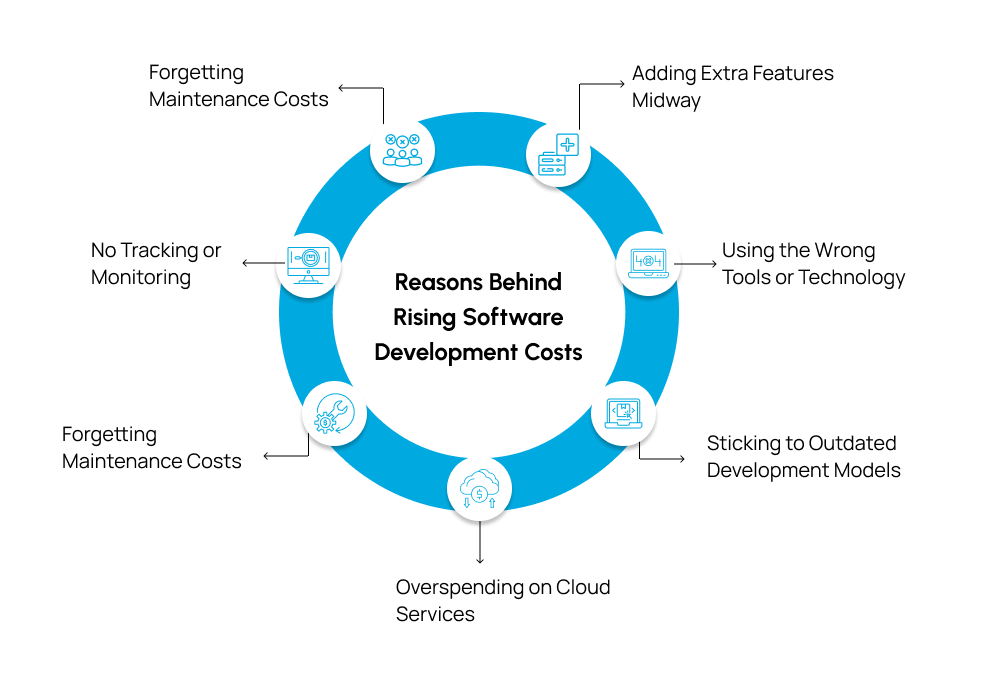Software development is a major investment for businesses of all sizes. Building apps, upgrading existing solutions, or broadening digital capabilities often come with costs that outpace initial projections. Many companies face budget overruns because of poor planning, shifting requirements, or technical inefficiencies.
You have to be aware that you can reduce costs without compromising quality. First, let’s look at the reasons why software projects often get expensive, and then explore the top 7 ways to cut costs effectively.
Why Software Development Costs Increase
Software development costs often rise when projects lose focus or lack proper planning. Adding features midway, choosing the wrong tools, relying on outdated models, or hiring the wrong team can quickly inflate budgets. Without tracking progress, accounting for maintenance, or controlling cloud spending, expenses spiral out of control, turning a manageable project into a costly challenge.

Cloud platforms are powerful, but without monitoring, unused resources or over-provisioning can quickly rack up unnecessary bills.
Top 7 Ways to Reduce Software Development Costs
1. Track Progress with Clear Metrics
Every successful project needs measurable progress indicators. Tracking delivery speed, error rates, and team productivity allows you to spot issues early. Instead of waiting until deadlines are missed. For example, if error rates spike in a sprint, you can immediately reassign resources or review code quality. Metrics actually give you a roadmap to keep development efficient and costs under control.
2. Pick Affordable and Reliable Tools
Not every project needs the most expensive technology stack. What matters is finding tools that meet your needs without draining your budget. Open-source platforms like PostgreSQL, React, or GitLab can save thousands in licensing costs while still being reliable and scalable. Choosing wisely helps balance cost-effectiveness with performance by ensuring you’re not paying for features you don’t actually use.
3. Use Agile Development Methods
Old school project delivery methods often lead to wasted time and features nobody needs. Agile solves this by breaking development into smaller sprints with constant feedback from users or stakeholders. This means you deliver value in increments, adapt to changes quickly, and avoid unnecessary work. The result is, it lower costs, faster releases, and happier clients.
4. Outsource Wisely
Outsourcing can be a cost-saver but only if done strategically. Instead of outsourcing the entire project, delegate specialized tasks like UI design, testing, or niche technical work to experts. This allows your core team to stay focused on the bigger picture. The key is clear communication: define expectations, goals, and deadlines upfront to avoid scope creep and hidden costs.
5. Build a Skilled and Proactive Team
A proactive team anticipates problems and suggests improvements. Skilled developers and testers help reduce errors, speed up delivery, and skip unnecessary rework, which is often the hidden cost in software projects. Investing in training and inculcating a culture of accountability ensures your team becomes an asset that saves both time and money in the long run.
6. Control Cloud Spending
Cloud services are flexible, but they can also become a silent cost drain if left unchecked. Regularly review cloud usage, monitor resource consumption, and use auto-scaling features to pay only for what you actually need. Shut down idle servers and test environments when not in use. By treating cloud spending like a project deliverable, you prevent small costs from snowballing into budget overruns.
7. Take Advantage of Open-Source Solutions
Open-source software is affordable and community-driven. Popular libraries and frameworks often come with reusable components, reducing the amount of code you need to build from scratch. Strong developer communities mean faster troubleshooting and support without paying for premium licenses. Using open-source effectively can dramatically cut down both time and costs in development.
Conclusion
Most expenses on software development arise from unclear goals, poor tools, and inefficient processes. By setting clear requirements, choosing the right technology, adopting agile methods, outsourcing wisely, and controlling cloud spending, you can keep projects within budget while still delivering excellent results.
In the end, reducing costs is about building efficiency into every stage of development planning, execution, and maintenance. When done right, a software development company stays powerful in speeding up delivery and improving long-term scalability.
